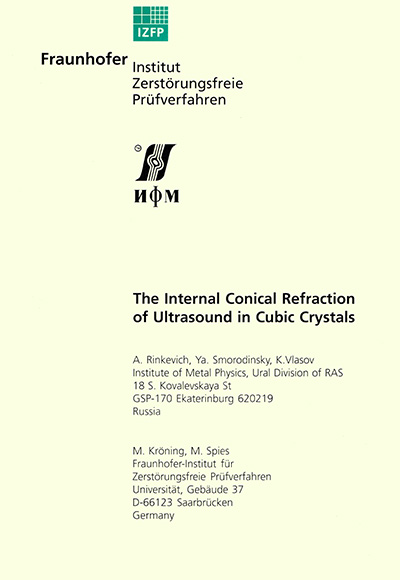The International Conical Refraction of Ultrasound in Cubic Crystals

Авторы: A. Rinkevich,Ya. Smorodinsky, K. Vlasov
Информация о издательстве: Germany: Fraunhofer-Institut fur Zerstorungsfreie Prufverfahren Universitat, 2000. – 81 pp.,
The internal conical refraction effect lies in the deviation of energy flow direction of elastic wave despite the wave propagates along the acoustic axis. The complete review is presented of the theory including the energy flow of the beams. The effect of electric and magnetic fields is discussed. The calculation methods of elastic field polarization are reduced under the conical refraction condition. The methods of the experimental investigation are shown.
The direction of the ultrasound energy flow in an anisotropic medium generally differs from the direction of the wave normal. These directions may coincide in some crystallographic directions only. This is the case, in particular, when an elastic wave propagates along the transverse acoustic axis, provided the mirror symmetry plane of the crystal is the normal to this axis. If the said symmetry plane is absent, the beam velocity vector deviates from the axis despite the velocity degeneration of the transverse modes. As a result, a special effect -the internal conical refraction of ultrasound - may set in.
The analogy between propagation of elastic and electromagnetic waves in an anisotropic medium has been well known. The phenomenon of the internal conical refraction (ICR) has long been known in optics. Analyzing propagation of light in a two-axis crystal, Hamilton predicted this phenomenon in 1833. The ICR was observed experimentally by Lloyd in the same year. The main properties of the ICR have been known since 1905. However, even to the present day the phenomenon of the internal conical refraction has been difficult to appreciate. In acoustics this phenomenon was observed for the first time by de Clerk and Musgrave in 1955. It reduces to the deviation of tne ray velocity vector from the acoustic axis, along which the ultrasound propagates. The direction of the ray velocity vector depends on polarization of the transverse wave. If the polarization changes 180 degrees, the ray velocity direction changes 360 degrees. Thus, if the polarization is varied, the ray velocity vector describe a conical surface.
This cone may be either an elliptical or circular one. In 1959 Waterman fully described the propagation of plane elastic waves in crystals, including the effect of the internal conical refraction. The theory of this effect allowing for the real structure of the wave field was advanced by A.G. Khatkevich. The analogy between elastic and light waves was frequently used to ascertain qualitative features of this phenomenon.
This review is concerned just with the effect of the ir ternal conical refraction (ICR) in cubic crystals. The findings on the crystals having other symmetries are used here as may be necessary. The ICR in tetragonal and hexagonal crystals and in orthorhombic crystals has been treated in Refs. and respectively. The phenomenon of the external conical refraction-the formation of a cone of wave normals corresponding to the given ray-has been known in crystal acoustics, too.
This review mostly is a compiled treatise. The contents of the review have been arranged in accordance with the following scheme. Our initial concern will be the theory of the ICR effect in cubic symmetry crystals, in particular the propagation of plane waves. The effect that deviation on the propagation direction from the axis of third-fold symmetry has on the energy flow will be discussed. Special situations of the ICR-reflection of the beam from the boundary surface and generation of the second wave harmonic-will be considered. Finally, the experimental refraction observation methods will be described.